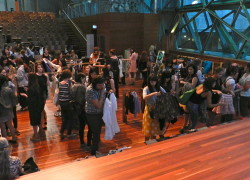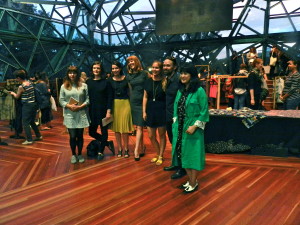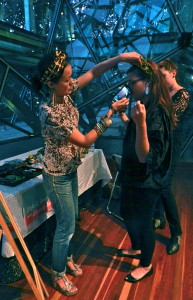
“I have an overflowing wardrobe, but nothing to wear.”
In today’s clothing climate, it’s a common turn of phrase. Festering floordrobes, nurtured by our love to shop, wear once, and quite literally – drop, are slowly swallowing the bedroom floors of fashionistas worldwide.
According to the gang at The Clothing Exchange, the average Aussie wardrobe contains 104 unused items. We wear approximately 20 per cent of our clothing 80 per cent of the time, and, as a nation, spend $1.7 billion dollars on clothes we rarely sport.
When gazing at the healthy hoards of fabric bursting out from behind un-closable closet doors, being a style-stasher doesn’t seem like such a hefty crime. But when the cold, hard facts are considered, a hint of self-reflection occurs. As a group of fashion fanatics with sustainable sentient discovered this week, it’s time to ditch the cheeky buy-and-deny, and enter retail rehabilitation.
Savvy, sophisticated and sustainable. These are the words that united the otherwise diverse troupe of panellists at Wednesdays Wardrobe Workshop. Hosted by the Melbourne Clothing Exchange in partnership with the 2015 VAMFF Cultural Program, this in depth discussion saw an ensemble of industry leaders come together to address the peculiar phenomenon of the overflowing “drobe”.
Mats Ekstrom from slow fashion retailer Swensk, BusinessChic blogger Cheryl Lin and sustainability consultant Fabia Pryor joined Violette Snow and Sigrid McCarthy, the lovely ladies behind Melbourne’s most sustainably stylish publication, HESSIAN, to guide what was a truly enlightening and ideal-examining chat.
Fronting an audience of fashionistas enthusiastic for ethical improvement, founder of The Clothing Exchange Kate Luckins and Melbourne swap meet host, Linn Vikander bounced questions around the panellists, addressing issues such as, ‘why do we keep things we don’t wear?’ and ‘how can we turn our overflowing wardrobe into a functional wardrobe, while still enjoying the frivolity fashion has to offer?’
Ekstrom credited his male clientele as leaders of the minimalism mission. “They shop with a purpose,” he explained, “and this usually includes buying something that means they don’t have to return for another three years.”
But Lin, Pryor, Snow and McCarthy suggested it’s possible to consume carefully.
“Editing your wardrobe doesn’t mean divorcing yourself from the fun of fashion. Take it as a challenge to hone your personal style, keep the pieces that compliment this and trade those that don’t away,” proposed Pryor.
Following the conversation was The Clothing Exchange’s personally curated wardrobe-waste solution. Why drop, when you can swap? With each member of the audience bringing a small bag of unwanted garments to trade for pre-loved pieces, it became evident that despite suggestions of slow fashion being ‘boring’, swapping can procure just as much fun than shopping. And with the expert assistance of Vogue Japan’s Leeyong Soo in the styling booth, we learnt it’s possible to look hip in hand-me-arounds.
Hosting wardrobe exchanges every couple of months, if you, like us, are currently guilty of cultivating a hefty crop of clothing, take yourself, your friends, and a bag of your finest unworn apparel along to the next meet.
You’ll trade forgotten treasures for some stylish new steals, and have a whole heap of fun in the process. And, with all un-swapped items going to charity, we’re sure the brains behind The Clothing Exchange have found the most enjoyable solution to the wardrobe-waster yet.
Swap/Style/Snap, and you won’t look back.
For more details on The Clothing Exchange, visit clothingexchange.com.au



